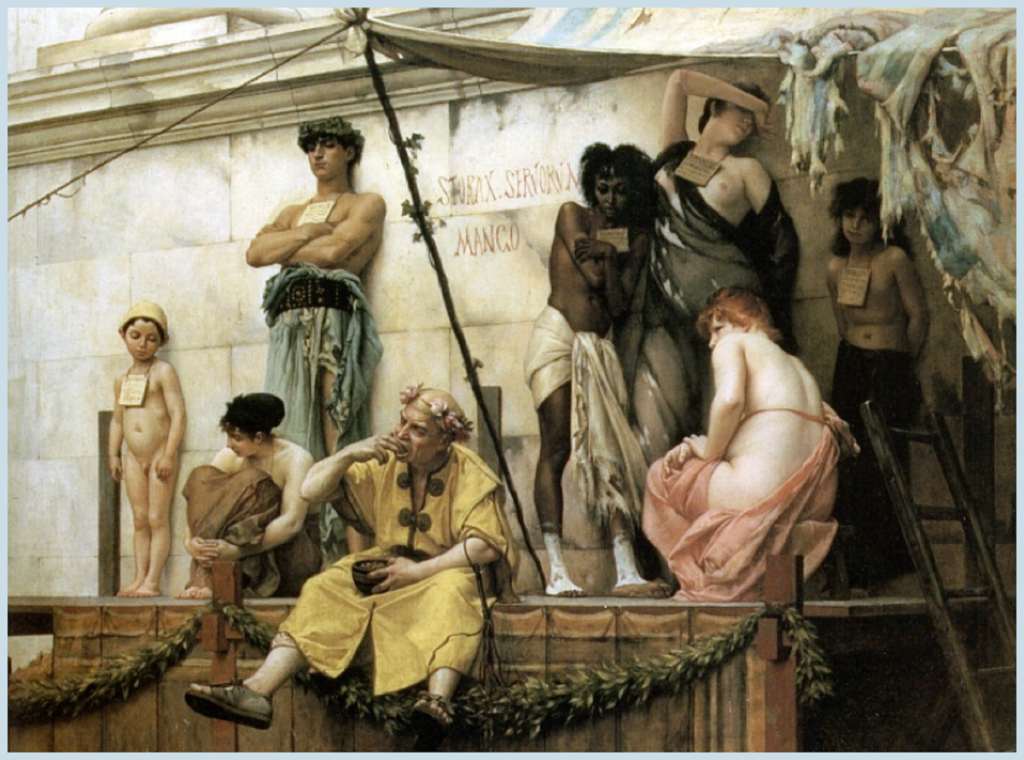Last updated on January 29th, 2023 at 10:51 pm
Slavery was an everyday fact of life in the Roman Republic and the Roman Empire which followed it.
Although scholars have to rely on approximations and the prevalence of slavery varied over time, it is estimated that upwards of 20% of the population of the Roman Empire were slaves. That would be roughly 15 million people out of a total population of perhaps 75 million at the height of the empire in the second century AD.
Moreover, the concentration of the slave population was particularly high in certain areas. In Italy, where the patrician class who gained most from the empire’s expansion were based, over 30% of the population were slaves in the imperial age.
So, given that well over ten million person were enslaved across the empire at any one time, what was life like for a Roman slave?

How Did People Become Roman Slaves?
The reality was that life could vary significantly from case to case. Some were born into slavery, and some had it imposed upon them.
Unsurprisingly, those born into it were the children of slaves.
Conversely, those born free and enslaved later in their lives could end up in this position in various ways. Some were foreign people captured and enslaved during one of Rome’s many wars. This could be with people beyond Rome’s borders, such as the Germanic tribes or a people who had recently been conquered, as occurred in southern Britain in the first and second centuries AD.
People could also become if they fell into major debt or were found guilty of a serious crime. The modern world is unusual because it incarcerates people for months or years if they commit a crime.
Most earlier societies either imposed fines, physically punished, or enslaved the guilty party. One would not find prisons across the Roman Empire except those used to hold individuals long enough to crucify them. Once people were enslaved, they were usually auctioned off at a slave market.
What was life like for a Slave?
Life for the slave could be dictated considerably by whether they were born free. Often it was more tolerable for those who were born into slavery.
For instance, a second or third-generation slave of an equestrian-class family living near Rome generally had a reasonably stable life. The enslaved people occupied a position comparable to that of nineteenth-century domestic servants.
This varied according to who one’s owner was, but if one was an amiable individual, life might not have been too harsh, and there was the possibility of earning one’s freedom if one served well enough for long enough.
In contrast, life for a newly enslaved person could be much more brutal. For instance, because those slaves captured in war were more likely to be male fighters, they were more likely to be bought by a gladiatorial school.
If this was the case, life could be nasty, brutish, and short, with such a person often dying just months later on the sands of one of the 400 amphitheaters prevalent in all the empire’s major cities.
Another dreadful fate was to end up damnati in metallum, condemned to the mine. Mines in Roman times were dangerous places, and the work was arduous. One did not want to end up as a slave working in one of them.
While many individuals ended up in gladiatorial schools or mines, it should be noted that most slaves held more basic roles.
Slaves and the Roman Economy
Most performed roles typical for the modern middle class in the United States. Some were barbers, cooks, hairdressers, and wet nurses, while others even acted as scribes and officials within the municipal governments of towns and cities.
Moreover, their living conditions were very often quite good. Slaves who lived in the domus or villa or a Roman noble would probably have had living quarters and a diet that would have surpassed the poor free person in Rome.
Indeed there was a widespread practice of poor free persons electing to become slaves to improve their living conditions. This emphasizes that slavery in Roman times was very different from the kind of chattel slavery seen in the sugar, tobacco, and cotton plantations of the Americas between the sixteenth and nineteenth centuries.
Of course, there were other abuses. There seems to have been a general expectation that slaves could be used for sex by their owners, and there were almost certainly many instances where slaves were beaten or treated poorly by their masters or mistresses.
Nevertheless, on the other side of things, freed slaves could become Roman citizens. Many of them rose to positions of substantial power within the Roman government, much like the freedmen Phaon and Epaphroditus did during the reign of Nero.
Indeed the lack of major slave revolts throughout Roman history would seem to suggest that life was broadly tolerable for the majority of slaves.
Thus, as one might expect with a group that made up approximately 20% of the population of the Roman Empire and, by extension, about 5% of the world’s population in the first and second centuries AD, the experience of a being a slave in Rome differed widely, from the benign to the brutal.
Perhaps it reflected life in any society, and people have had vastly different living conditions throughout modern history.

